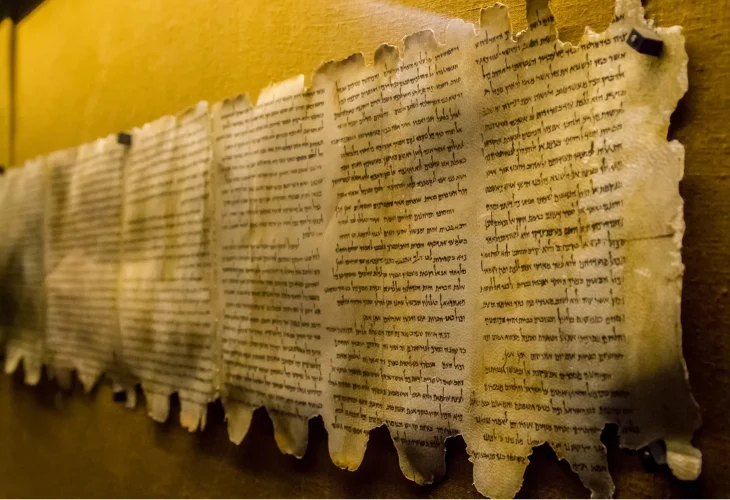As discussed in a previous article, the discovery of the Dead Sea Scrolls decisively undermined the claim that multiple versions of the Bible circulated in Israel during the Second Temple period. In reality, thousands of biblical fragments dating to various stages of the mid–Second Temple era were uncovered, yet none showed evidence of significant textual or ideological divergence.
However, the implications of the scrolls went even further. Another major branch of biblical-critical theory collapsed when confronted with the realities revealed by these discoveries.
Faced with the evidence, proponents of biblical criticism shifted their claims. They conceded that multiple versions did not exist during the Second Temple period—but argued instead that the alleged changes and edits must have occurred much earlier.
The difficulty with this claim lies in the implausible and anachronistic manner in which these edits are described. The Dead Sea Scrolls provide direct insight into how texts were actually written and copied in antiquity, exposing narratives that lack any grounding in historical or technical reality. According to many prevailing theories, scribes added comments and alterations directly onto Torah scrolls, which later scribes then incorporated into the main text. But is such a process realistically possible?
Professor Emanuel Tov addressed this question in a dedicated article titled “Writing and Rewriting in Ancient Scrolls: Implications for Biblical Criticism.” He writes:
“One primary question is whether scribes could technically alter a fully written book in a significant way. In my opinion, this was almost impossible. First, one must consider writing on parchment and papyrus within fixed margins. The technical difficulties involved in making corrections within such a rigid framework were immense, due to the limited space in column margins and the physical limitations of the material itself. The ability to make corrections was minimal, and once writing was complete, there was simply no space. It is unlikely that ancient scrolls had wider margins than those found at Qumran, and the inter-column margins left little room for additions, generally containing no writing at all.”
Beyond theoretical concerns, there is also no physical evidence supporting the feasibility of such editing. An examination of countless biblical manuscripts reveals no trace of systematic rewriting or editorial layering. As Professor Tov explains:
“The Qumran findings regarding biblical and non-biblical scrolls show no tangible traces of rewritten scrolls. In the biblical manuscripts, we found no physical evidence of content rewriting—neither in minor details nor in major passages. Our analysis of scribal techniques and the Qumran discoveries demonstrates that generations of scribes or editors—whatever term one prefers—did not embed rewritten material into existing copies. Rewriting, additions, or omissions could not have been executed through corrections to existing scrolls because of the physical constraints inherent in scroll writing. In fact, the technical challenges of writing and correcting texts in antiquity were even greater than those faced in the final centuries BCE.”
From the earliest days of biblical criticism, particularly within historical-literary scholarship, many researchers assumed that biblical books were composed of successive layers built upon earlier versions. These hypothetical layers were said to introduce or remove narratives, lists, chronologies, psalms, and other material.
Such assumptions lie at the very foundation of biblical-critical methodology. Yet, as Tov observes, little attention has been paid to the practical realities behind these claims:
“In introductory works, commentaries, and scholarly studies, much is said about textual layers and lengthy insertions. However, scholars have rarely asked how, in practical terms, one could insert an entire section into a completed scroll—or remove material from the middle of a column.”
Professor Tov surveys various scholarly attempts to explain the supposed technical mechanisms behind such “additions” and concludes succinctly:
“The descriptions of scribal practices offered by scholars do not reflect reality.”
In effect, scholars constructed elaborate theories that bore little resemblance to the physical realities of ancient manuscript production, all in an effort to substantiate claims of textual alteration within the Torah.
Tov adds a telling observation:
“To be honest, scholarly perceptions appear to be influenced more by modern writing habits than by the realities of ancient scroll production. Scholars were not considering the complexities of writing on ancient scrolls, but rather projecting the flexibility of modern biblical editions onto the past. We have grown accustomed to the ease with which extensive changes can be made to texts in mere seconds.”
The contrast is stark. Stories and theories are one thing; material reality is another. Yet despite the evidence, new narratives continue to be devised—each seeking, once again, to claim forgery or editorial manipulation within the Torah, regardless of what the scrolls themselves reveal.


